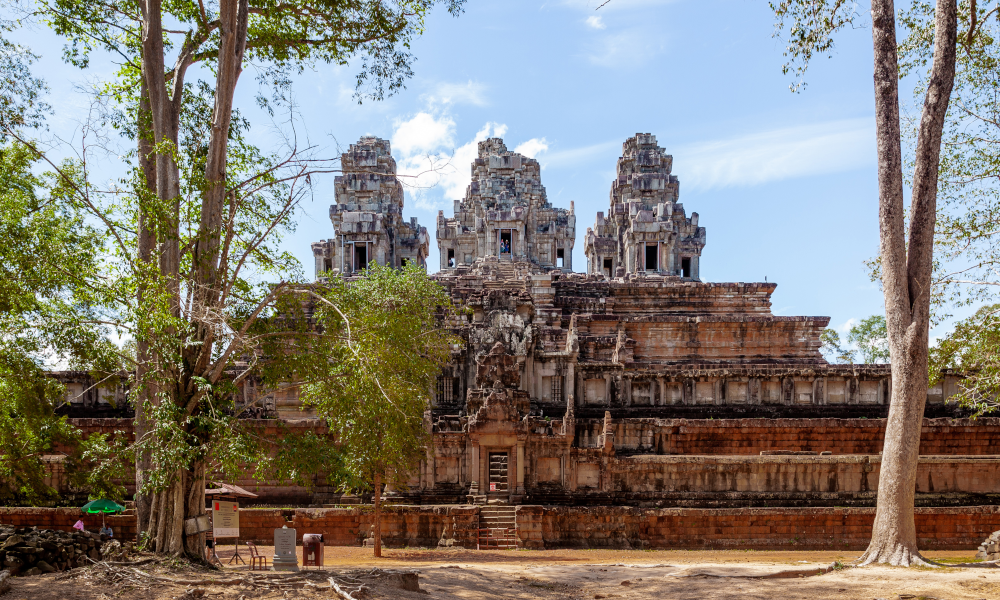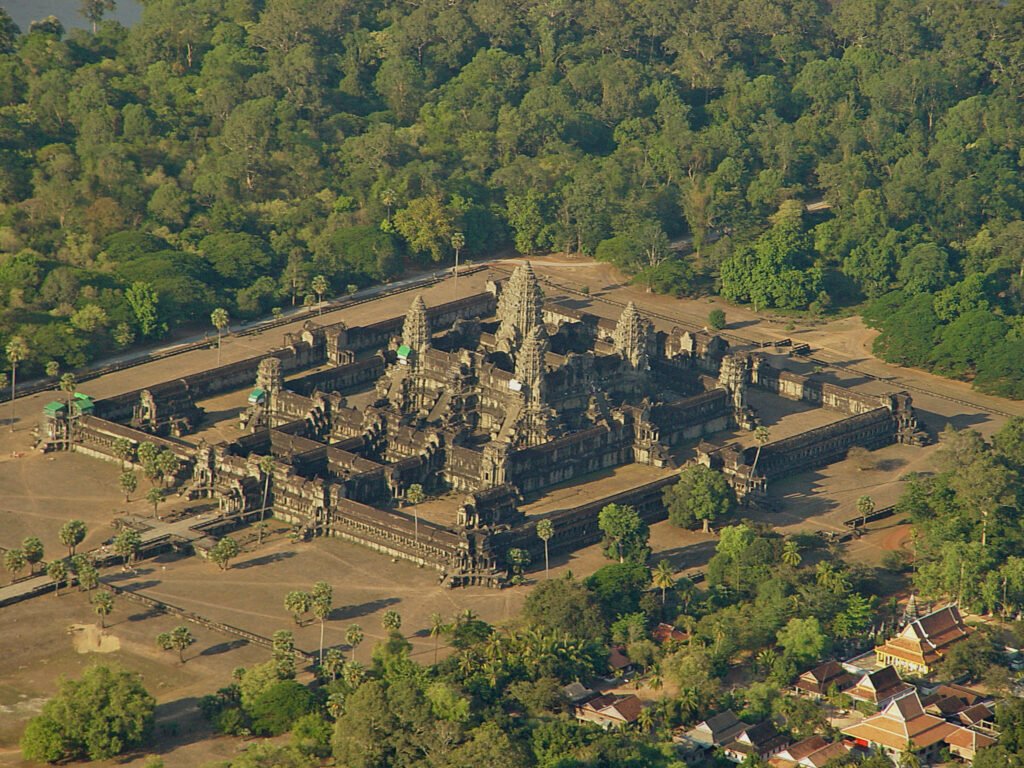Ta Keo Temple - Tower of Crystal

The grand ziggurat of Ta Keo, the most mysterious of the lesser temples, rises toward the sun with a dignity and strength reminiscent of Angkor Wat. It is adorned with lush greenery and topped with trees, yet it remains dominant over the surrounding forest.
Its rugged formations, towering above the coconut palms, create the impression that it has recently ascended from an underground cavern, bringing the forest along in its dramatic rise.
The absence of elaborate ornamentation sets Ta Keo apart from other Khmer structures, which are often lavishly decorated. However, this very simplicity endows it with significant architectural value, reflecting a new spirit among the people and an evolution in aesthetic sensibility.
Ta Keo is situated to the east of Thommanon and Chau Say Tevoda, with access available through the southern or eastern entrances.
Start and end in Siem Reap! With the In-depth Cultural Tour Best of Siem Reap 4-Day Tour. Best of Siem Reap 4-Day Tour includes accommodation...
Layout and Design
Ta Keo served as the state temple for King Jayavarman V and was designed to closely resemble the state temple of his father, Pre Rup. The temple features five sanctuary towers positioned atop a five-tiered pyramid structure. Surrounding this temple mountain is a moat, symbolizing Mount Meru, the legendary abode of the Hindu deities.
As one of the largest temples constructed during the Khmer Empire, Ta Keo’s imposing size is accentuated by the scarcity of carvings or sculptures, as decorative work had only commenced before construction was halted.
This temple holds historical importance as it was the first to be entirely constructed from sandstone.
The Tiered Pyramid: The base tier of the pyramid is encircled by a substantial sandstone wall, featuring four entrance gates (gopuras), one located on each wall. The eastern entrance gate leads to a spacious room measuring 20 meters, which likely served as a shelter for visitors and travelers. The dimensions of this first tier and its outer wall are 122 meters by 106 meters.
The second terrace measures 80 meters by 75 meters and is bordered by galleries, although these lack doors. This suggests that the galleries were intended for decorative purposes rather than functional use. Exploration of this second tier is hindered by numerous stones scattered across the floor, and certain areas are restricted to visitors.
The Upper Tiers: The upper three tiers are notably steep and narrow, contributing an additional height of 14 meters to the overall structure. Each side of the temple features a steep staircase, though not all are accessible to tourists.
Atop the highest tier, one can find the five sanctuary towers, with one tower positioned at each corner and a larger sanctuary at the center. Each tower is equipped with doors that open in all four directions, a distinctive feature for temples constructed before Ta Keo, which typically had false doors on three sides, with only one door facing east.
History of Ta Keo
The Ta Keo temple’s construction commenced under the reign of King Jayavarman V in 975 AD. However, it was not until approximately 25 years later that the temple was consecrated to Shiva. Following the death of Jayavarman, the construction was halted, leaving Ta Keo incomplete.
Inscriptions indicate that the temple was struck by lightning, which was interpreted as an ill omen, potentially explaining the cessation of construction. Despite this, Ta Keo remained a site of worship until the 13th century.
It is believed that the temple fell into abandonment during the 16th century, coinciding with a broader trend of disuse among many temples of that era.
Ta Keo was rediscovered in the late 19th century.
Why Visit Ta Keo?
Ta Keo enjoys significant popularity as it is among the larger temples within the park. Its uniqueness lies in the fact that it was never completed and features minimal decoration. The temple is enveloped by a dense jungle. From the summit of Ta Keo, one can observe the treetops of lush greenery extending in every direction.
Location & How to Get There
Ta Keo is situated within the Angkor Archaeological Park, just east of the historic city of Angkor Thom. It is approximately equidistant from Ta Prohm and the Victory Gate of Angkor Thom. Adjacent temples include Chau Say Tevoda, the hospital chapel, and Thommanon.
To reach Ta Keo, exit Angkor Thom through the Victory Gate along Victory Way. Proceed past Chau Say Tevoda temple on your right and cross the Siem Reap River. Continue along the road as it curves to the right, and you will find Ta Keo temple on your left.
Other Temples
-
Ak Yum Temple
-
Tep Pranam Temple
-
Khleangs Temple
-
Spean Thma
-
Prasat Suor Prat
-
Preah Pithu Group
-
Preah Palilay
-
Terrace of the Leper King
-
Terrace of the Elephants
-
Phimeanakas Temple
-
Banteay Prei Temple
-
Banteay Srei Temple
-
Prasat Kravan Temple
-
Ta Keo Temple
-
Chau Say Tevoda Temple
-
Thommanon Temple
-
Pre Rup Temple
-
East Mebon Temple
-
Ta Som Temple
-
Neak Pean Temple
-
Phnom Bakheng
-
Phnom Krom Mountain
-
Preah Khan Temple
-
Roluos Group
-
Banteay Kdei Temple
-
Baphuon Temple
-
Banteay Samre Temples
-
Beng Mealea Temple
-
Ta Prohm Temple
-
Bayon Temple
-
Angkor Thom Temple
-
Angkor Wat Temple
Experiences in Siem Reap
-
Cambodia Visa Requirements: All thing you need to know
-
Cambodia SIM Card: How to buy and price details
-
Money Exchange in Cambodia: What travelers need to know?
-
Useful Contacts For Travelers In Cambodia
-
Tourist Info Center: When Travel in Cambodia
-
Angkor Archeological Park
-
Suggested Siem Reap Itineraries
-
Reasons Against Financial Assistance to Begging Children
-
Pub Street
-
Siem Reap’s Local Markets
Cambodia Guide
-
Preah Vihear Province
-
Tonel Sap
-
Siem Reap Province
-
Cambodia Seasons
-
Mekong River
-
Battambang Province
-
Kampot
-
Sihanouk Ville
-
Phnom Penh: The campital city of Cambodia
-
National Religion of Cambodia - Buddhism
-
The History of Cambodia
-
Introduction to Cambodia
-
Public Holidays in Cambodia
-
Best Time to Visit Cambodia

